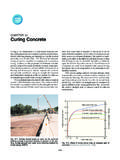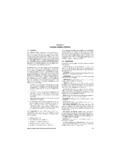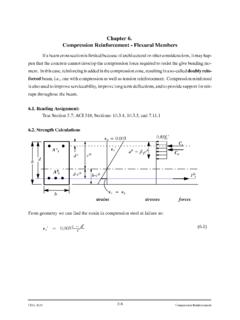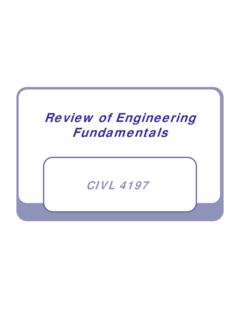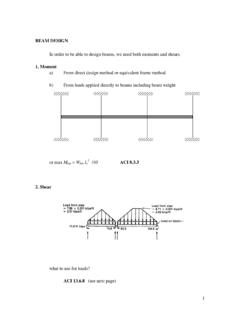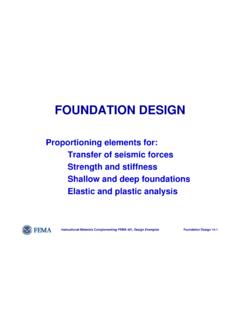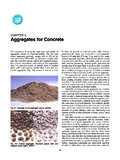Transcription of CIVL 7/8111 Chapter 1 - Introduction to FEM 1/21
1 A First Course in finite ElementsIntroduction The finite element methodhas become a powerful toolfor the numerical solution of a wide range of engineeringproblems. Applications range from deformation and stress analysisof automotive, aircraft, building, and bridge structures tofield analysis of heat flux, fluid flow, magnetic flux,seepage, and other flow First Course in finite ElementsIntroduction With the advances in computer technology and CADsystems, complex problems can be modeled withrelative ease. Several alternative configurations can be tried out on acomputer before the first prototype is built.
2 All of this suggests that we need to keep pace with thesedevelopments by understanding the basic theory,modeling techniques, and computational aspects of thefinite element 7/8111 Introduction to finite Element Method (FEM) 1/66A First Course in finite ElementsIntroduction In this method of analysis, a complex region defining a continuum is discretized into simple geometric shapes called finite elements . The material properties and the governing relationships are considered over these elements and expressed in terms of unknown values at element corners.
3 An assembly process, duly considering the boundary conditions, results in a set of equations. Solution of these equations gives us the approximate behavior of the First Course in finite ElementsPiecewise linear function in one 7/8111 Introduction to finite Element Method (FEM) 2/66A First Course in finite ElementsPiecewise linear function in two two dimensional domainDiscretization of two dimensional domainA First Course in finite ElementsCIVL 7/8111 Introduction to finite Element Method (FEM) 3/66A First Course in finite ElementsA magnetic problem using FEM softwareColors indicate that the analyst has set material properties for each zone, in this case a conducting wire coil in orange; a ferromagnetic component (perhaps iron) in light blue; and air in grey.
4 FEM solution to the problem The color represents the amplitude of the magnetic flux density, as indicated by the scale in the inset legend, red being high First Course in finite ElementsCIVL 7/8111 Introduction to finite Element Method (FEM) 4/66A First Course in finite ElementsA First Course in finite ElementsCIVL 7/8111 Introduction to finite Element Method (FEM) 5/66A First Course in finite ElementsA First Course in finite ElementsCIVL 7/8111 Introduction to finite Element Method (FEM) 6/66A First Course in finite ElementsA First Course in finite ElementsCIVL 7/8111 Introduction to finite Element Method (FEM) 7/66A First Course in finite ElementsA First Course in finite ElementsCIVL 7/8111 Introduction to finite Element Method (FEM) 8/66A First Course in finite ElementsA First Course in finite ElementsCIVL 7/8111 Introduction to finite Element Method (FEM) 9/66A First Course in finite ElementsThis example duplicates a benchmark problem for time-dependent buoyant flow in porous media.
5 Known as the Elder problem, it follows a laboratory experiment to study thermal convection. This model examines the Elder problem for concentrations through a 2-way coupling of two physics interfaces: Darcy s Law and Solute First Course in finite ElementsChemical vapor deposition (CVD) allows a thin film to be grown on a substrate through molecules and molecular fragments adsorbing and reacting on a surface. This example illustrates the modeling of such a CVD reactor where triethyl-gallium first decomposes, and the reaction products along with arsine (AsH3) adsorb and react on a substrate to form GaAs 7/8111 Introduction to finite Element Method (FEM) 10/66A First Course in finite ElementsA typical automotive exhaust system is a hybrid construction consisting of a combination of reflective and dissipative muffler elements .
6 The reflective parts are normally tuned to remove dominating low-frequency engine harmonics while the dissipative parts are designed to take care of higher-frequency noise. The muffler analyzed in this model, is an example of a complex hybrid muffler in which the dissipative element is created completely by flow through perforated pipes and First Course in finite ElementsThis example models the radiation of fan noise from the annular duct of a turbofan aeroengine. When the jet stream exits the duct, a vortex sheet appears along the extension of the duct wall due to the surrounding air moving at a lower speed.
7 The near field on both sides of the vortex sheet is 7/8111 Introduction to finite Element Method (FEM) 11/66A First Course in finite ElementsDamping elements involving layers of viscoelastic materials are often used for reduction of seismic and wind induced vibrations in buildings and other tall structures. The common feature is that the frequency of the forced vibrations is low. This model studies a forced response of a typical viscoelastic damper. The analysis involves two cases: a frequency response analysis and a time-dependent First Course in finite ElementsThis model treats the free convection and heat transfer of a glass of cold water heated to room temperature.
8 Initially, the glass and the water are at 5 C and are then put on a table in a room at 25 C. The nonisothermal flow is coupled to heat transfer using the Heat Transfer 7/8111 Introduction to finite Element Method (FEM) 12/66A First Course in finite ElementsThe complete analysis consists of two distinct but coupled procedures: a fluid-dynamics analysis with the calculation of the velocity field and pressure distribution in the blood (variable in time and in space) and the mechanical analysis with the deformation of the tissue and artery.
9 The material is assumed to be nonlinear and a hyperelastic model is First Course in finite ElementsThis model studies the fluid flow through a bending pipe in 3D for the Reynolds number 300,000. Because of the high Reynolds number, the k-epsilon turbulence model is used. Calculations with and without corner smoothing are performed. The results are compared with experimental 7/8111 Introduction to finite Element Method (FEM) 13/66A First Course in finite ElementsThis model simulates the time-dependent flow past a cylinder.
10 The velocity field magnitude at different time steps is First Course in finite ElementsHistorical Background Basic ideas of the finite element method originated from advances in aircraft structural analysis. In 1941, Hrenikoff presented a solution of elasticity problems using the frame work method. Courant s paper, which used piecewise polynomial interpolation over triangular subregions to model torsion problems, appeared in 1943. Turner et al. (1956) derived stiffness matrices for truss, beam, and other elements . The term finite element was first coined and used by Clough in 7/8111 Introduction to finite Element Method (FEM) 14/66A First Course in finite ElementsHistorical Background In the early 1960s, engineers used the method for approximate solution of problems in stress analysis, fluid flow, heat transfer, and other areas.

